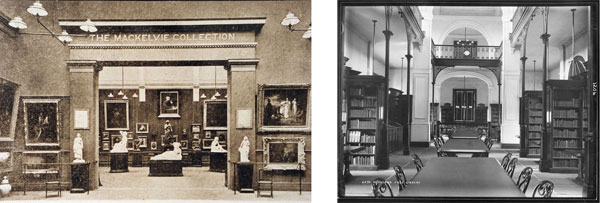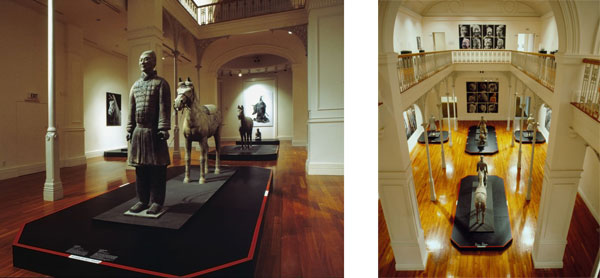Wednesday 26 January 2011
Jane Davidson-Ladd
For reopening, I have been working on an exhibition that looks at the Gallery’s architecture - from the competition for its design in 1883 to the present day development. Of course, a building’s history is much more than the bricks and mortar with which it’s made. It has made me wonder: ‘if these walls could talk, what would they say?’

City Gallery, looking through to Mackelvie Gallery, 1897 (left), Auckland Free Library reading room (today’s Wellesley Gallery), 1889 (right)
The building has served as not only an art gallery, but also Auckland’s main public library until 1971; and in its early years also housed council offices. So what are your memories of the building and its various purposes? Are there favourite exhibitions? Particular performances or events that still resonate? Memories of singular art works? Experiences of rooms or spaces and how they’ve changed?
To start the ball rolling here are some of mine...
My earliest memory of the Gallery is looking down from the mezzanine level of the Wellesley Gallery to take in the Chinese Buried Warriors – a truly awe inspiring sight for a 10 year old.

The Buried Army of Qin Shihuang, Aug – Oct 1986, installation views, Wellesley Gallery
Another early memory is of the historic international collection installed in the Mackelvie Gallery following the 1980s renovation. What sticks in my mind in particular is the moss green carpet, which I wrongly remember running over the walls, as well as the floor! I was fascinated by Pietro Paolini’s The Fortune Teller: Its velvety tones and textures; the wicked exchange of gestures and glances; the story that was very evidently behind the painting.

International collection, installation view of the Grey and Mackelvie Galleries, 1985 (left), Pietro Paolini, The Fortune Teller, oil on canvas, Auckland Art Gallery Toi o Tāmaki, gift of Mr Norman B Spencer, 1961 (right)
I recall waiting for what seemed like hours to get into Rembrandt to Renoir as a high school student (although appalling little about the exhibition itself) and writing copious notes in my 6th form art journal about a very inspirational talk by then curator, Alexa Johnston, in The 50s Show. It was the first time I was truly aware of the dramatic possibilities of exhibition making.

The 50s Show, Nov 1992 – Mar 1993, installation view (left), John Reynolds, Raft of the Medusa, 1992, mixed media on plywood, Auckland Art Gallery Toi o Tāmaki, gift of the Patrons of the Auckland Art Gallery, 1993 (right)
While at University, I remember encountering Ralph Hotere’s Godwit Kuaka and John Reynold’s Raft of the Medusa shortly after the ground floor galleries were refurbished in 1998 (bye-bye carpet!). The scale and the quality of the works really impressed upon me the calibre of our contemporary artists.
And then, I found myself working at the Gallery in late 2002. I was particularly starry-eyed when I started – I had my ultimate dream job. Just to walk through the Gallery to my office every morning was a privilege. When shows would change over there was the palpable sense of discovering works anew and having my own private viewing.
Since that time, there are favourite exhibitions I have worked on. Bringing together Colin McCahon’s 1960s Waterfall series with the 18th-century William Hodges painting that originally inspired him in Fall of Water, Fall of Light. Celebrating Rembrandt’s 400th birthday and his influence as a master etcher in Masters of the Bitten Line.

Rembrandt van Rijn, Rembrandt in a Heavy Fur Cap, 1631, etching, Auckland Art Gallery Toi o Tāmaki, purchased 1961 (left), Te Moananui a Kiwa, installed in Mackelvie Gallery with Michael Parekowhai’s Kapa Haka (Pakaka), 2003 in immediate foreground (right)
Another instance that particularly stands out: the placement of Michael Parekowhai’s Kapa Haka (Pakaka) in front of 19th-century New Zealand landscapes. It was a juxtaposition that was intended to work on several levels – but it performed an unexpected one. When leaving the building after hours, a number of staff including security reported jumping at the sight of the hulking figure standing guard in the dark. Even during opening hours, you often did a double take at his presence.
So, what are your memories of the building and what has occurred within it? Did you study in the Wellesley Gallery when it was a library? Attend the highly memorable Artichoke, when the entire collection was hung edge-to-edge? Is there a particular work you are looking forward to reacquainting with? We’d love to hear.